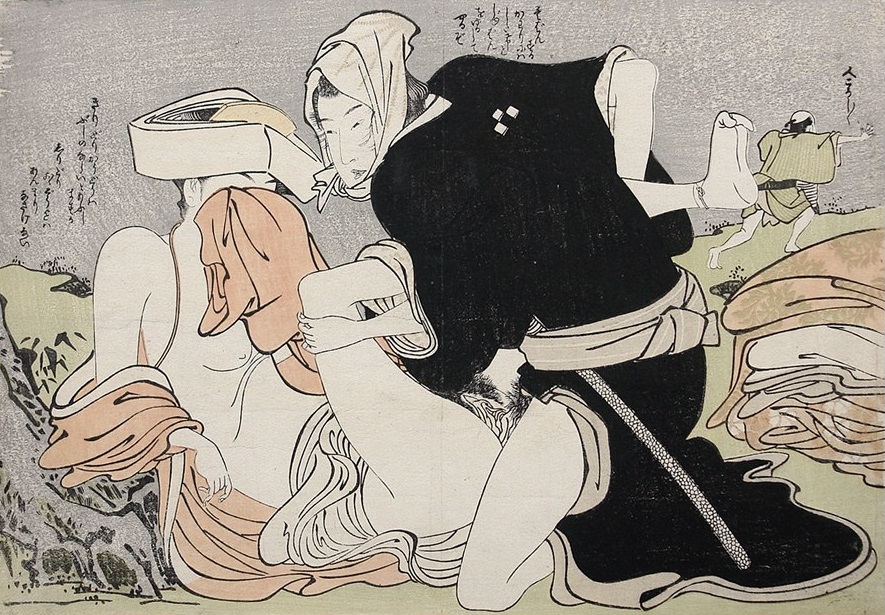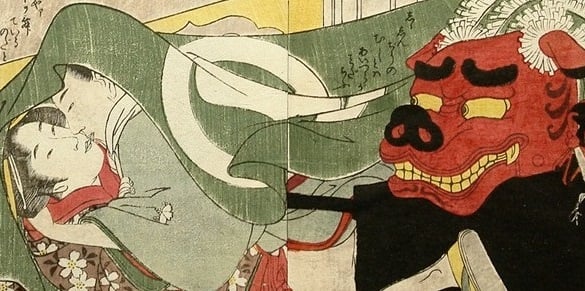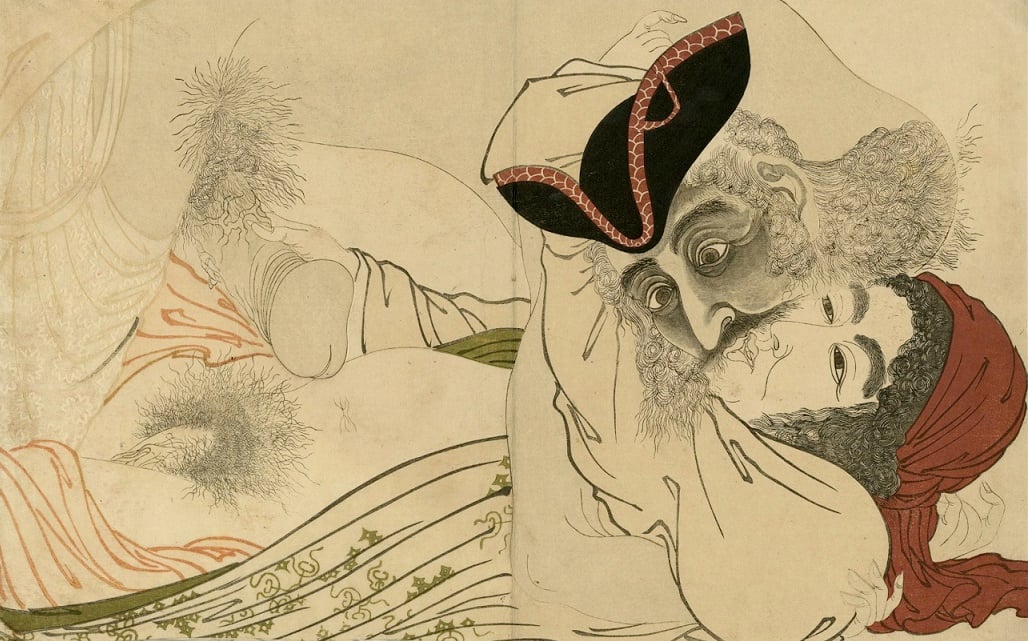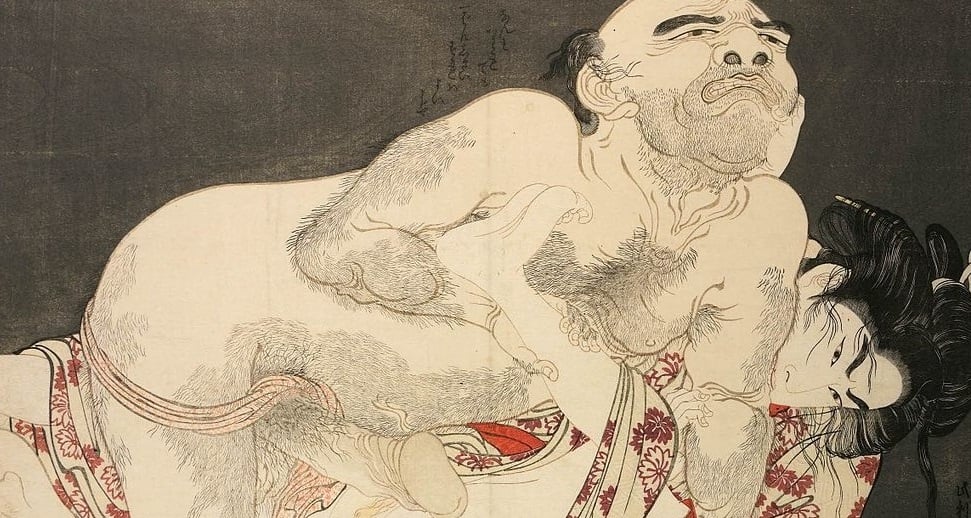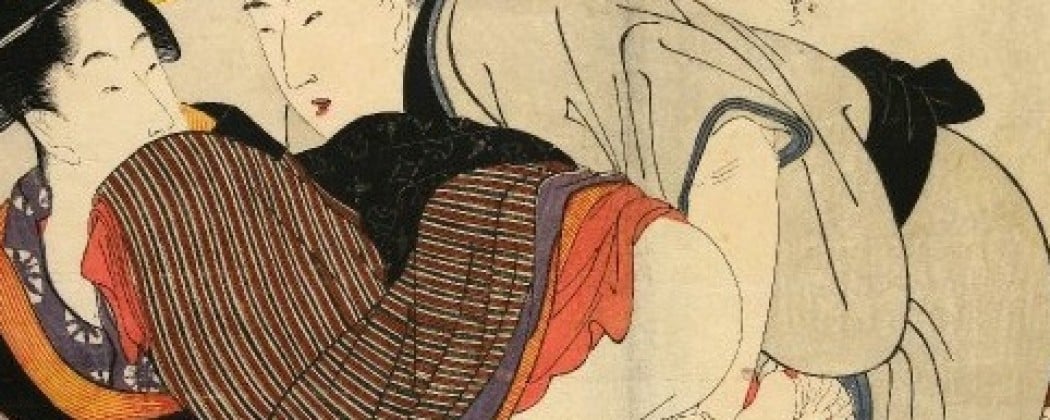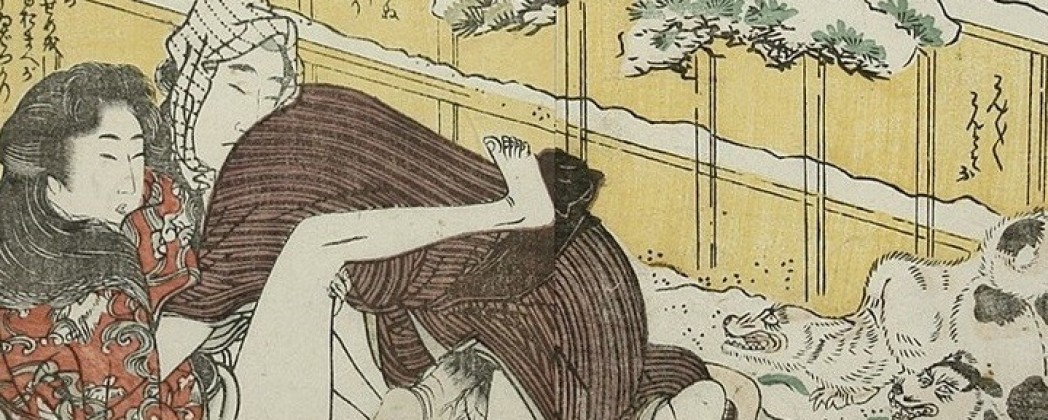
Of all Japanese artists, and perhaps all Asian artists after Hokusai, Utamaro is possibly the best known in the West. To a great extent he owes his reputation to Edmond de Goncourt’s biography, the celebrated pioneering work Utamaro: le peintre des maisons vertes (Utamaro: Painter of the Green Houses), published in Paris in 1891.
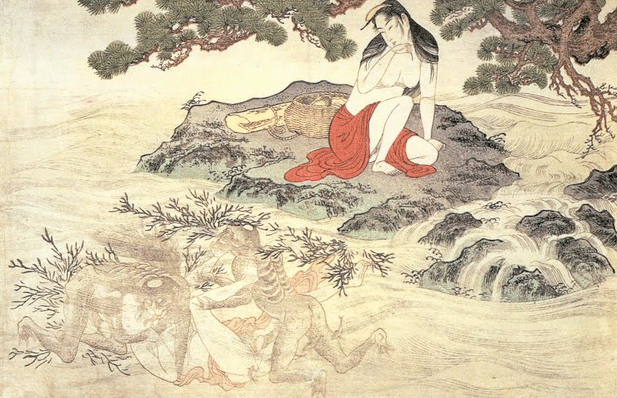
Fig.1. ‘Kappa rape‘ scene from the series ‘Poem of the Pillow (Utamakura) , c.1788
Hedonistic Genius
Utamaro is above all the supreme portraitist of female beauties in the Floating World. His profile as an artist, like his personal life, is closely linked with the life of the pleasure quarters and the famous publisher Tsutaya Juzaburo (1750-1797). His intimate knowledge of the workings of the Yoshiwara may have been facilitated by the fact that Tsutaya’s production of the bi-annual guidebooks, Yoshiwara saiken, was so closely related to the fortunes of this pleasure district. Despite the recent efforts of some art historians, the dominant image of him is still that of the hedonistic genius. Someone leading the sort of bohemian life that developed in Europe in the late nineteenth century.
Poem of the Pillow
Kitagawa Utamaro (1753-1806) made his great breakthrough around 1788 with the production of the singular shunga set, Poem of the Pillow (Utamakura, 1788). Utamaro’s first independent prints date from 1777, and he would prove to be an extremely prolific artist. Utamaro produced an estimated 2,000 single-sheet prints during a career spanning just under thirty years. Like Kiyonaga and Shuncho, Utamaro worked almost exclusively in the genre of bijinga. He left the other main genre of his day – Kabuki actor prints – to Utagawa Toyokuni I (1769-1825), Utagawa Kunimasa (1773-1810) and Toshusai Sharaku (act. c.1794-95).

Fig.2. ‘Violent Rape in a Garden’ From the series: ‘Ehon hana fubuki (Picture-book of Flowers in Violent Bloom)’, c.1802. (Available in our gallery for Euro 850,-)
Notoriety
Utamaro’s Poem of the Pillow evinces a maturity in style and is distinct from any work by his contemporaries. In the same year as the release of the Poem of the Pillow, that is, 1788, Utamaro demonstrated his artistic versatility with another Tsutaya publication, The Insect Book (Ehon mushi erabi). This book was a collection of kyoka by prominent Edo poets accompanied by Utamaro’s prints of insects and plants. It has even been suggested that Tsutaya was the instigator of this book (and many other illustrated by Utamaro; see Asano and Clark 1995: text vol., 257). Utamaro had gained a degree of notoriety as an artist because of the seemingly concurrent publication of the album Poem of the Pillow and the expensive kyoka album The Insect Book. Not only as an artist but because he was now under the guidance of Tsutaya. Some of his greatest designs were to follow.
Vulgar
According to Dr. Richard Lane Utamaro‘s work in shunga can be divided in three periods. The first period, which covered thirteen years, began in 1780, when he was using the name Toyoaki. During this period he peaked with the Poem of the Pillow series and Ehon hime hajime (1790). The latter was a joint work with Katsukawa Shuncho (1783-1795).
This first period Utamaro had less artistic control over his works which seem to follow a manuscript written by someone else. Also the composition is focused on the setting, not on the human figures. The content is also unlike that of Utamaro‘s illustrated books in his later periods since it includes vulgar scenes.

Fig.3. ‘Intimate Couple and disturbing dog’ from the series ‘Ehon karanishiki (Picture-Book of the Chinese Brocade), c.1802. (Available in our gallery for Euro 950,-)
Madly Busy
From the second period (1795-1800) on, Utamaro conceived the illustrations himself and is also thought to have devised the dialogue written on the plates. This period were his most productive years. After the death of his patron Tsutaya Juzaburo he was freed from the straitjacket and could spread his wings and soar. Utamaro comments in the Ehon iro no chigusa (Various Plants and Flowers of Love Affairs), c.1798, “Artists are madly busy”. He seems to have been full of energy and ambition.
The third period stretched from 1801 to 1805. Utamaro‘s mastery at this final stage of his career was truly genial, relaxed, and serene. Gone is the inflexibility and hardness of line that we saw in the artist’s early work; here he succeeds in combining linear fluency with a vibrantly evocative, erotic power. Utamaro developed to the fullest in these last years.

Fig.4. ‘Relaxing Couple’ From the series ‘Ehon warai jogo’ (The Laughing Drinker)’, c.1803. (Available in our gallery for Euro 865,-)
A nice example of this is his series ‘Ehon hana fubuki (Picture-book of Flowers in Violent Bloom)‘ from 1802 (see Fig.2). It was published synchronously in poylchrome and black-and-white versions. The use of color is truly remarkable, and the carving is outstanding in its precision and skill. Extraordinary skill was required, for example, to express the flowing beauty of precisely combed hair.
Most Successful
Perhaps because by the time Utamaro produced Hana fubuki, he had nearly 20 shunga books under his belt, the compositions offer no novelty. But in this luxurious setting, Utamaro‘s men and women come alive and free in an indulgent utopia. In 1802 Utamaro created one of his most successful books called Ehon karanishiki (Picture-book of Chinese Brocade). Every design (see Fig.3) is distinguished by a certain clarity, uncluttered by dialogue or unnecessary detail.
In what is perhaps Utamaro‘s last erotic book series Ehon warai jogo (The Laughing Drinker) that was published c.1803 he displayed for a last time in this format his great mastery. The images in the book have powerful colours and show not only scenes of love full of delicacy (see Fig. 4 and 5).

Fig.5. ‘Husband and Wife’ from the series ‘Ehon warai jogo’ (The Laughing Drinker), c.1803. Available in our gallery for Euro 865,-)
Imprisonment
In 1804, Utamaro was accused of breaching censorhip laws with the publication of a politically sensitive triptych illustrating Toyotomi Hideyoshi (1536-98). He was the last military ruler of Japan before the establishment of the Tokugawa shogunate. Utamaro was convicted and given a sentence in early summer of that year. Along with several of his colleagues, including Utagawa Toyokuni I (1769-1825), of fifty days in mannacles under house arrest. He died two years later in 1806.
Click here for a profound introduction to the art of shunga (Utamaro, Hokusai…etc.) !
We have some nice Utamaro pieces for sale in our gallery!
Sources: ‘Poem of the Pillow and Other Stories‘ by Gian Carlo Calza and ‘The Complete Ukiyo-e Shunga‘ by Dr. Richard Lane.

